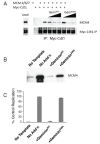An inactive geminin mutant that binds cdt1
- PMID: 25988259
- PMCID: PMC4488664
- DOI: 10.3390/genes6020252
An inactive geminin mutant that binds cdt1
Abstract
The initiation of DNA replication is tightly regulated in order to ensure that the genome duplicates only once per cell cycle. In vertebrate cells, the unstable regulatory protein Geminin prevents a second round of DNA replication by inhibiting the essential replication factor Cdt1. Cdt1 recruits mini-chromosome maintenance complex (MCM2-7), the replication helicase, into the pre-replication complex (pre-RC) at origins of DNA replication. The mechanism by which Geminin inhibits MCM2-7 loading by Cdt1 is incompletely understood. The conventional model is that Geminin sterically hinders a direct physical interaction between Cdt1 and MCM2-7. Here, we describe an inactive missense mutant of Geminin, GemininAWA, which binds to Cdt1 with normal affinity yet is completely inactive as a replication inhibitor even when added in vast excess. In fact, GemininAWA can compete with GemininWT for binding to Cdt1 and prevent it from inhibiting DNA replication. GemininAWA does not inhibit the loading of MCM2-7 onto DNA in vivo, and in the presence of GemininAWA, nuclear DNA is massively over-replicated within a single S phase. We conclude that Geminin does not inhibit MCM loading by simple steric interference with a Cdt1-MCM2-7 interaction but instead works by a non-steric mechanism, possibly by inhibiting the histone acetyltransferase HBO1.
Keywords: Cdt1; DNA replication; HBO1; geminin; pre-replication complex.
Figures





References
LinkOut - more resources
Full Text Sources
Other Literature Sources
Research Materials
Miscellaneous

